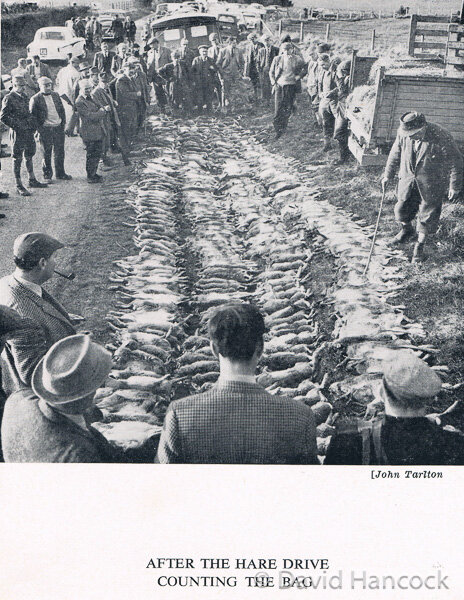1182
HARE-CARE – RUNNING A COURSE
By David Hancock
In the quite outstanding book on sporting dogs: The Greyhound and the Hare by Charles Blanning, published in 2018, there is an excellent foreword by Sir Mark Prescott, that contains these illuminating words: “On the Swaffham Coursing Club’s best land, during the week following the ban, 3,000 hares, previously conserved for the coursing meetings, were shot in three days. In no coursing season since 1972 had more than 297 hares been killed, countrywide, in a year. Thus, the sport would have had to continue throughout the country for another one hundred years to have killed as many hares as those that were shot in the first week of the coursing ban at Swaffham alone.” He was referring to the ban on hare-coursing, that resulted from a massive campaign by ‘animal-welfarists’. Do politicians and legislators actually understand what the consequences of their careless Commons’ decisions have on the ground, in the field? Coursing devotees liked and respected their quarry, conserved it and treasured it as a species, who does that now?
The widely held view that hare-coursing had the sole purpose of killing hares, rather than comparing the running and turning skills of a pursuing brace of sighthounds, soon became accepted wisdom. Pro-coursing lobbyists just couldn’t swim against the tide and the ‘antis’ exploited this quite shamelessly. The most humane system for the control of foxes shouldn’t be debased by an irrational dislike of men on horses in pink coats. If it is agreed that fox-control is essential, especially in hill areas, why not employ the soundest method of doing so? Nature is viewed by so many town-dwellers as a place where a collection of lovable animals live in harmony, whereas nature in reality is astonishingly cruel. Human ignorance about animal welfare is not bliss and no basis for activist energy. Are wild animals ever likely to benefit from innocent ignorance or from conspiring humans with a political agenda?
Have foxes and hares benefited from such conspiracies? Or is it little to do with animal welfare when the truth is known. Sadly, maimed foxes can survive a fox-shoot. Not many hares escape a hare-shoot. A study in the May 2005 issue of Animal Welfare, the journal of UFAW, showed that up to 50% of foxes shot with shotguns were wounded not killed. I understand that in no coursing season in the last two decades of the twentieth century were more than 300 hares, of the 2,000 coursed, killed. Just under 400,000 hares were shot annually on non-coursing estates for control purposes during that time. And the hare was welcome on coursing estates. Sport is about seeking a contest not extermination; the coursing community respected hares. It is the hunter’s natural instinct to preserve what he hunts. The Veterinary Association for Wildlife Management has stated that hunting is the natural and most humane method of controlling populations of all four quarry species and is a key element in the management of British wildlife in general. That is how our sporting dogs were fashioned.
A highly-regulated country sport with very strict rules, like coursing, brings with it respect for the quarry and the country being used. No other country sport has to give its quarry a fair start or law; no other sport provides escape routes on the course. The sport of coursing was all about the contest between two competing hounds and not the catching of the quarry. As Professor Roger Scruton, writing in the Winter 2009 issue of the magazine Hunting put it: “The opponents of hunting see it as a kind of primitive battle, in which the quarry is overcome by unfair military tactics and a cruel war of attrition. For the hunt followers, however, the hunt is an equal contest, governed by rules of engagement which respect the hunted animal while giving the greatest possible scope to the hounds that are pursuing it. True, the quarry is singled out for a life and death struggle which it did nothing to provoke. But this ‘singling out’ exalts the fox or stag in the eyes of its pursuers and imposes on them the ethic of fair play.” This ‘ethic of fair play’ used to be the leitmotif of country sports and a way of bringing young adults into maturity with respect for nature and the countryside around them. The young tyro hunter off with his lurcher for a day’s sport once demonstrated the timeless trinity of man, dog and the land. Hunting rabbits has so far not been targeted – perhaps because they are regarded more as vermin than game.
In his masterly Rural Rites, Hunting and the Politics of Prejudice of 2006, Charlie Pye-Smith writes: “Anyone who wishes to ridicule the Act, and test it to the limits, will have no trouble doing so. Take, for example, the hunting of hares. It is illegal under the Act to hunt hares with dogs. However, you can hunt hares with as many hounds as you like providing you are pursuing hares which have been shot.” If any perverse sadist elected to maim hares with a high-powered air rifle, he could then legally course them. Is this truly how animal welfare should be enacted? Do-gooders so often end up being evil-doers. The rules of coursing did more for animal welfare than could any legal action arising from the words of this vengeful Act. Many of those opposing field sports have the strange concept of nature being left alone and being better for it. Not in 21st century over-populated Britain! Without man’s intervention, most wild creatures would starve or die of disease. Their needs rely on human control and in enlightened not prejudiced ways.



